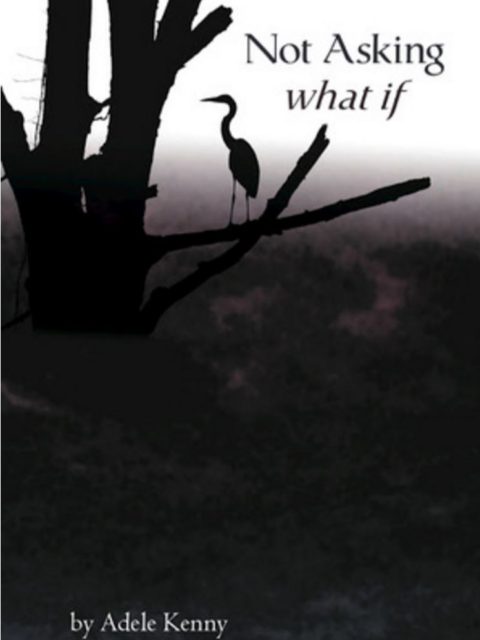 “Not Asking what if”
“Not Asking what if”
by Adele Kenny
Muse-Pie Press
ISBN: 978-0-918452-51-8
Perfect Bound
80 Pages, 105 Haiku
June 2016
Not Asking what if
Review by Emily Vogel
Just before I began reading Adele Kenny’s new book of haiku, I paid a visit to a nun, concerned that I had not been to daily mass in a while. But the previous week, I had stayed at my father’s lake house, in solitude, and was surrounded by the beauty of nature. The nun iterated to me that “God is everywhere, not just in the church. When you are at the lake,” she said, “do you sense the presence of God?” The next week, I traveled to the lake house a second time, and read through Kenny’s poems, from cover to cover. These haiku all certainly indicate the reality that “God is everywhere.” More spiritual in a sense than religious, Adele Kenny’s recently released book, “Not Asking what if” seems to have been birthed from the introspection that comes with deep contemplative prayer.
The book of haiku follows the trajectory of each season throughout the span of a year, beginning with autumn, and concluding with summer. In each season, Kenny pays homage to elements and aspects that are particular to that time of year. Each haiku usually captures a singular image that elucidates a quiet stirring of a certain profundity, such as:
“abbey bells
muffled by dusk
as the hills lose shape”
This singular image brings to mind that particular surreality of dusk actually being responsible for the disappearing hills, whose shape is so prominent in the daylight. And sometimes, she brings these haiku into what is almost a “zen” sensibility:
“leaf among leaves —
what the moment
is”
Kenny also circles to the self’s emotional state in many of these poems, so that there is a very emotional narrative as the seasons change:
“distant, a car door closes —
this lingering
sadness”
And in winter:
“the wind shifts —
I didn’t know
I was crying”
And in spring:
“where lupines bloom
I unlearn
who I am”
The profundity of these haiku actually stems from the simplicity of each image — each “snapshot” bearing a deepness of meaning. The meaning is manifested effortlessly from the connection between the self and nature. In a sense, the epiphanies of the self are derived directly from these inklings that nature subtly presents. In this book, the speaker expresses a humble, and almost innocent wisdom about the universe, both on micro and macro levels.
Near the end of the spring section is the title poem:
“Not asking what if —
the heron’s silhouette
becomes the tree”
This reads like the beauty of a hallucination, which in effect creates a very surreal image — but the trick is, she is not asking what if—which gives us the sense that even without asking, supernatural things can occur—which brings to mind Matthew 6:8: “Your Father knows what you need before you even ask him for it.”
Reading Adele Kenny’s haiku out here by the lake was not just an “eavesdropping” on her particular spiritual experience, but was a spiritual experience for me as well. Kenny is a true spiritual poet, with sharp visions that arise from what at first glance, seem like usual aspects of nature and the world, but which she transforms into profound concepts.
The last two poems in the book (summer) conjure her childhood, and adumbrate her apprehensions of being known, either by others or by God:
“where the path disappears,
I remember the words
of a childhood prayer”
And:
“in these deep woods,
no trace of me,
not even a footprint”
The irony strikes me: these words in this book of haiku have certainly made a footprint. This is a book highly recommended for quiet reading in solitude, where “Not Asking what if” can become your loyal companions.
About the reviewer:
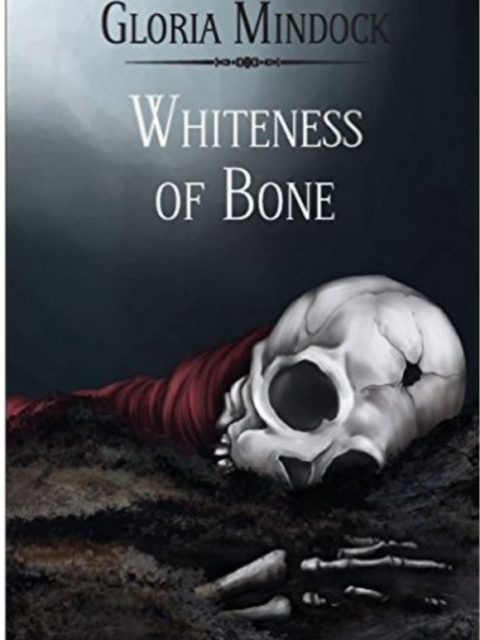 Whiteness of Bone
Whiteness of Bone
by Gloria Mindock
Glass Lyre Press
Perfect Bound
86 Pages
ISBN 978-1-941783-19-1
Copyright 2016
Whiteness of Bone
Review by Michael Foldes
Empathy. And horror. I am beaten over the head by it. From page to page, the poems in “Whiteness of Bone” hammer home the interminable inhumanity of man against man, in this case, the inhumanity of man against man, woman and child. Gloria Mindock captures in 80 pages the nearly unimaginable cruelty experienced by people around the world subject to planned and extemporaneous killing. From genocide to criminal endeavors, hatred and anger bleed from these pages, while the poet herself bleeds for the victims.
In “Ascension” she writes:
They all were led to an embankment,
pushed over.
Shot in the head or hacked.
Piles of bodies, a crime.
The courage of those who died made
their bodies beautiful…
Ascension into the air where God touched their soul.
Evil is evil so mourning is essential.
In the beginning reading these poems appears simply to be another expression of outrage against violence. I wonder from page to page when this will change. When will the poet come up for air. When will I be allowed to breathe again? It doesn’t change. It’s not just a diatribe. It’s a manifesto that reflects the reality of what’s happening around us while we (some of us) placidly go about our daily routines as if there were no other way in the world to live. A photograph in The New York Times prompts the poem, “In Cambodia, the Bridge”:
The bodies wrapped in woven mattes are lined up in the corridor
of the hospital. Bodies of the young, old… Panic crushed the people
into broken bones, hearts, skulls underfoot thinking it would make a
beautiful picture in The New York Times. Little did they know that they
would die today…
The images are unrelenting: machete attacks, rape of women, girls and boys, mass graves … The deeper I dig into these poems, the deeper I dig into the graves of those whose lives and the lives of their loved ones are soiled by the excrement of actions no sane person would carry out, no civilized society would exhibit. No civilized society would tolerate. And yet we do.
There is so much despair inside these piles of bones that I cannot think of not reading to the end, to see if there will be an end, to see if there is any light in that dark world. The poet recognizes this inhuman condition has existed always, and has little hope that life on earth will ever see peace — beyond eternal peace when the angels take your hand and then take flight.
In “Deafness” she writes:
All over the world,
the building blocks of death.
No questions asked.
No dreams reached. Life cut short by greed.
Bullets hit bodies and the soil
grabs the blood. Holds it but
there is no nutrition.
Grief is hear all over the world, but the
world forgot to take out its earplugs.
Rwanda, Guatemala, Pakistan, El Salvador. The horrors are described in poems with titles such as “End,” “Annihilation,” “Missing,” “Shrapnel,” “Avenging.” The title poem, “Whiteness of Bone,” pleads for something better, emits a glimmer of hope:
The rain washes the blood
| into the earth today.
For some strange reason, the
rain is only heard. No gunshots,
No screams, no wind blowing
death around, just a silence.
Bodies, unburied, sometimes
unrecognizable, motionless.
I need to cover them.
Let them rest in peace.
Nothing was accomplished
by this slaughter.
And later:
All the bones saturate the ground.
One can learn about the life and death of the
dead by holding them.
I hear you, know you, there is no vacancy
in my heart as your life closes in.
The whiteness of bone, I caress, kiss and
retrieve your memories for a better life.
Mindock provides a painful reminder to the very end that victims do not die alone:
El Salvador, Rwanda, and Bosnia, I am your messenger.
A girl who talks every night to the stars.
One by one, they listen and are confused,
They die out without solution.
Four billion years and man is still igniting the shadows.
Whiteness of Bone will not bring the world to peace with itself, but it certainly will make the reader aware of that grievous shortcoming.
About the reviewer:
Michael Foldes is founder and managing editor of Ragazine.CC. You can read more about him in About Us.
Memorials to Shattered Myths
Vietnam to 9/11
By Harriet F. Senie
Oxford University Press
260 Pages
by William C. Crawford
This book is a highly readable academic exposition which examines the history and ethos behind a number of our primary national memorials. Ms. Senie provides astute technical, political, and social insights into the evolution of some of our best known public monuments.
Her extensive treatment of the 9/11 site is especially relevant for me because I experienced a less than satisfactory visit to Ground Zero in the midst of reading this volume.
The author also gives extensive analysis to the Vietnam Veterans Memorial, a project rendered quite difficult because the US didn’t win the war and public opinion about the conflict remains deeply divided even today.
My stake in this monument is also quite large. I was a grunt and later a photojournalist during the war. My best friend was killed in Antenna Valley in December, 1968. He died while we were both assigned to the same rifle company.
Ms. Senie asks how could the US commemorate this contentious conflict? The memorial design competition eliminated any political statement about the War, listing only the names of the KIA’s in dramatic, somber fashion. Maya Lin’s wall seems to spawn reflection and visitors respond to the location more as a cemetery than a place for heroic celebration.
The political rift around Vietnam has not healed since the installation of the Wall in 1982. Many Americans still have not reconciled their faith in the country, which they consider the most powerful in the world, with the fact that the US lost an undeclared war against a small country in Southeast Asia.
The American psyche is further tormented by the fact that two Presidents exaggerated and even lied (Gulf of Tonkin) about the circumstances there in order to garner public and Congressional support.
This situation is further complicated because a later President utilized similar chicanery to draw the US into an ill-fated invasion of Iraq. It is extremely difficult to commemorate soldiers, who no matter how heroically they perform, fought in conflicts with such dubious legal and moral authority.
The 9/11 site seeks to bear solemn witness to the terrorist attacks of February 26, 1993, and September 11, 2001. The museum and the reestablished skyscraper pay homage to the nearly 3,000 victims and all those who risked their lives to render assistance.
The towering site with surrounding accoutrements placed in lower Manhattan is very physically impressive. I visited for the second time in the heat of late June with the city and site teeming with international tourists.
I was immediately struck by the carnival like atmosphere which was now also heavily commercial. Vendors hawked memorabilia and the din was deafening. People pushed and shoved to capture the best spot to use their selfie sticks and phones to record the moment. I was accosted by sellers and jostled at every turn.
Respect and remembrance for the 9/11 victims was conspicuously absent. The milieu was purely festive. No sacred sense of the original tragedy was present outside on the site. My friend wryly observed that this scene was surely Disneyland New York!
Ms. Senie faithfully examines the ambivalence and difficulty with which Americans cope when they create public memorials. I found this book to be extremely informative but often troubling and ironic. Our populace and opinions are apparently too diverse to reach any concrete consensus even on public commemoration.
The author subsequently wrote an important short essay not included in this volume. In it she proposes the establishment of National Victims of Gun Violence Memorial on the Mall in Washington D.C. She sardonically suggests that it is only fitting to recognize these victims of a common death just as we have memorialized the deceased from Columbine, Oklahoma City, and the World Trade Center.
Hers is a strong commentary on the lack of common American will. Ms. Senie is an expert on US commemoration. It also seems that she has the conflicting, hypocritical values of the American psyche pretty well figured out as well.
Commemoration through monuments is a complex and contradictary subject in America. The author provides a wealth of expert analysis and well researched background material. In a ’round about fashion, Ms. Senie takes the reader on a deTocqueville like journey through America’s public psyche. The trip turns out to be both fascinating and at times terribly troubling.
About the reviewer:
William C. Crawford is a writer and photographer based in Winston Salem, NC. He can be contacted at .
Margaret the First
by Danielle Dutton
Publisher: Catapult
http://books.catapult.co/products/margaret-the-first
Published March 15th 2016
167 pages, 8.2 x 5.4 in, paperback, ($15.95)
ISBN-13: 978-1936787357
Cover art by June Glasson
Reviewed by Amber MV
Margaret the First, a brilliant new novel by Danielle Dutton, tells of the life of the seventeenth-century English author Lady Margaret Cavendish, Duchess of Newcastle-upon-Tyne. The book – aptly named as Lady Cavendish is truly a first of her kind – was inspired by accounts from Virginia Woolf relaying the charm of the noblewoman. Dutton weaves a sensuous story of glimmering visions intimately viewed through the eyes of Cavendish herself. The forty-nine years of Lady Margaret’s life elicit an affection and compassion in the reader for the unique, ambitious, sensitive, self-doubting, lovably eccentric character that Cavendish was in her time. Born Margaret Lucas, oft is she hailed as “the first woman to live by her pen,” in the words of author Kate Whitaker, biographer. Cavendish was a noblewoman who produced numerous plays, poems, essays, philosophies, romances and prose writings, and is best known for her novel The Blazing World, considered an early work of science fiction.
How refreshing it is to read the story of an early feminist figure who is freed by her imaginative solitude and introversion, as well as the enduring love of a good marriage. In Margaret the First we get a glimpse into the enormous creative interior life of Lady Cavendish, visions of ships sailing to frozen kingdoms commandeered by talking bear-princes. Dutton’s lively, inventive cadence of language dances over the page, experimental playfulness of word reflecting Lady Cavendish’s own pioneering in literature, her leaping thoughts. At once dream-like and compelling, we see through first-person eyes the life that is her own, now jumping to third person, as, to quote Cavendish in the novel, “scenes change according to my whim, for I was writing more freely than ever before” (page 88). The book is a delight for the inner eye – Dutton’s writing shimmers with the light of vivacious sight as a reader scarce has encountered before, an abundant sensuality of description.
Margaret Cavendish is alive again in this story, a dreamer who is not afraid to boldly wear her heart on her sleeve, much less to infamously wear it on her bare breasts in society, nipples red-painted. The king himself comes to visit! All are aswarm in gossip over this rare bird of a creature, The Lady Margaret who lives wholly in the heart-world of her own. She is the first woman to appear before the Royal Society of London in session, speaking or not speaking in the company of men as she chooses. Most closely to that wild heart is the quiet life shared with her adoring and patient husband, the nobleman William Cavendish, First Duke of Newcastle-upon-Tyne, thirty years her senior. The two devotedly support one another through all the harrowing ups-and-downs of long life, unable to conceive children, fleeing political troubles in a dangerously shifting England, civil war and puritanical censorship, business losses, scientific advances rearranging the known world, the change and constancy of the lands they return to. They are a true pair. The book stands out as a real-life historical love story, following Margaret and William through thirty-some years of loving marriage, until the writer is found passed away in her garden chair, aged forty-nine, sleeping as though she be gone to her Blazing World. William, in his seventies and devastated to outlive his beloved wife, lingers but three more years in this world before he departs it to join his beloved in hers.
The book is to be remarked upon as an intimate view into one woman writer’s inner life of vision, longing, creative process and love. We follow Lady Cavendish through the peaks and valleys familiar to any new or established writer; the need for solitude, the struggle to define one’s own voice against the vagaries of everything else in life, sorting apiece a mind full of thoughts and ideas and inspiration opening in offering to the world. “I had rather appear worse in singularity… than better in the mode” (page 121) says Margaret, ever true to her own sense of self. Cavendish, merely eccentric, is sometimes charged with arrogance or conceit in her desire for literary fame. But her memory cannot be blamed when even the credits for her own works at times were unjustly attributed to the men surrounding her. She constantly was made to advocate for women’s equal intelligence among men. Her story, as it is conveyed in this novel, gives the reader no just cause for accusation against her: Cavendish is a gentle, sensitive, visionary soul whose longing for fame is but a desire to be loved and valued for her worth as a writer respected by men, loved by the greater world which she so loved and drew breath from, the source of her Blazing World.
About the reviewer:
Amber MV holds a BA in Creative Writing and English from Southern New Hampshire University. She writes at her blog, The Leafy Paw, a “journal on the soul of the world,” at www.theleafypaw.com.
The Gospel of Simon
by John Smelcer
Leapfrog Press
Fredonia, NY
140 pages
Copyright 2016
ISBN 9781935248842
$14.95
Many are called,
few are chosen
Review by Mike Foldes
From an obscure passage in the Bible when a Roman soldier plucks a curious observer from a straining crowd lining the road to Golgotha and directs him to share the burden of an exhausted Christ by helping him carry his cross the final distance to his crucifixion, author John Smelcer generates a contrapuntal dialog as witness to the untold story of Simon. Simon, who became a believer. Simon, whose sons and grandsons through generations would protect and defend the truths and proofs inherent in their story.
Smelcer’s “Simon” is a simple man who happened to be in the right place at the right time to play a pivotal role in Christian theology. Smelcer recognizes the challenges facing Jews (then as now) who would recognize a Messiah, while advocating that the underlying truth in all religions is “to love they neighbor as thyself.” This dictum plays out in Simon’s life after Christ’s death and, as the story goes, His resurrection. Simon’s ability to give without expecting to receive results in the greatest gifts to himself and his family that one could ask for, which despite his questions and doubts, confirms the “rightness” of Christ’s teachings.
Smelcer’s tale does not come across as sermonizing, but as an internal dialog wherein he finds himself asking and answering — without being disingenuous — the same questions even the most devout will ask of themselves, others and their gods at one time or another in their lives. He is not telling, but showing, that the guiding principals of virtually all religions will lead to a better world that can be found if one can only pass “through those gates” where free will bends in the direction of “doing unto others as you would have them do unto you.”
Fictionalized to the extent that it “locates” the holy grail, as well as the timbers that formed the cross upon which Jesus was crucified, Smelcer makes no claim that Christianity is the only way to heaven, which leads the doors open to a place for all the world’s major religions. Thus, the great number of religious leaders and thinkers who have read and offered their comments about the book and its civility, as opposed to TV Preachers who try to convince their flocks that property is the measure of piety. Smelcer explores the deplorable. In showing us a man who answered the call, he also shows us there is a righteous, if not religious, path forward, if only we allow ourselves to take it.
About the reviewer:
Mike Foldes is founder and managing editor of Ragazine.CC. You can read more about him in About Us.
About John Smelcer:
John Smelcer is a frequent contributor to Ragazine.CC. You can find out more about him at http://johnsmelcer.com.

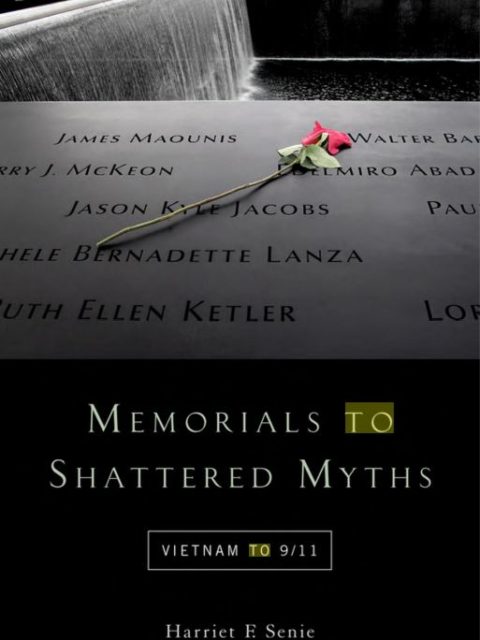
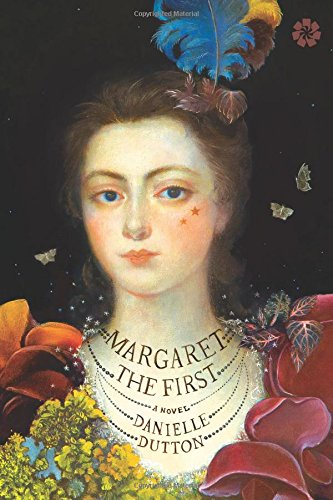

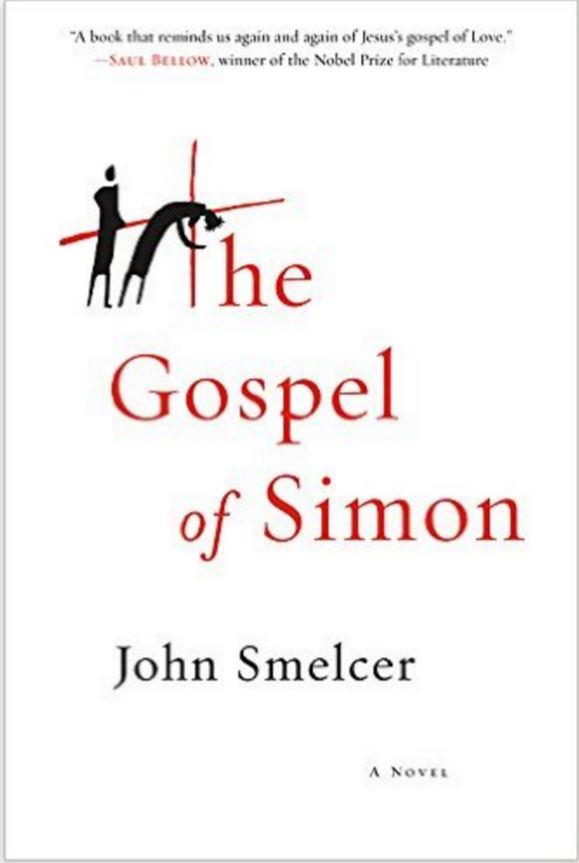
Recent Comments